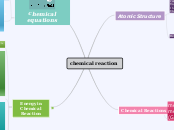chemical reaction
Energy in Chemical Reaction
Energy Change During ReactionsDuring chemical reactions old bonds are broken and new bonds are made.
-Energy can be taken in from the surrounding.
- Energy can be given out to the surrounding.This energy can be in forms of:
- Heat
- Light
- Sound
- Electricity
∆H - the symbol of difference in energy.
∆ is Greek capital letter “delta”, and is used to mean, “change”.
It is used in Science & Maths.
H represents energy and is sometimes called “enthalpy”
∆H = energy of products – energy of reactants
If the reactants contain more energy than the products ,
heat is given out (exothermic) , and ∆H will be negative .
If the products contain more energy than the reactants ,
heat is taken in (endothermic) , and ∆H will be positive .
∆H = energy of products – energy of reactants
- ENDOTHERMIC = ∆H is positive
- EXOTHERMIC = ∆H is negative
Exothermic:
Heat is given out
Reactants cool down
∆H is negative
Endothermic:
Heat goes in
Reactants heat up
∆H is positive
Energy Change During ReactionsDuring chemical reactions old bonds are broken and new bonds are made.
-Energy can be taken in from the surrounding.
- Energy can be given out to the surrounding.This energy can be in forms of:
- Heat
- Light
- Sound
- Electricity
When chemical bonds are broken energy is needed to break the bonds.
chemical equations
Every chemical has a symbol, alway begin with a capital letter; the 2 letter is alway small
Reactant - chemicals that start the reactant
Product - chemicals produced by the reaction
Ex: CO2 = 1 carbon + 2 oxygen
Reactant - chemicals that start the reactant
Product - chemicals produced by the reaction
Chemical Reactions
metal + oxygen = metaloxide (General Equation)
Conclusion: metal + acid = salt + hydrogen Magnesium reacts with sulfuric acid to form magnesium sulfate and hydrogen:
Ex: Mg (s) + H2SO4 (aq) = MgSO4 (s) + H2 (g)
Magnesium Sulfuric acid Magnesium sulfate Hydrogen
Metal Acid Salt Hydrogen
Conclusion:metal oxide + acid = salt + water -metal hydroxide + acid = salt + water -metal carbonate + acid = salt + water + carbon dioxide -
Reactions between Metals and Water
Alkali metals – group 1 Ex: lithium + water = lithium hydroxide + hydrogen
2Li (s) + 2H2O (l) = 2LiOH (aq) + H2 (g)
Lithium floats on water.
It fizzes and becomes smaller until it disappears
Reactions between Earth Alkali Metals and Water
Earth Alkali metals – group 2 Ex: magnesium + steam = magnesium oxide + hydrogen
Mg (s) + 2H2O (g) = Mg(OH)2 (aq) + H2 (g)
Atomic Structure
Reaction between Metal and Oxygen
Metal + Oxygen (reactants) = Metaloxide (product)
Reactivity: Because of the atomic structure of the metals; Groups 1 and 2 are more
reactive as you go down the group.
Valence electrons are easier to get lose since they are further away from the nucleus; This means more reactive.
Potassium
Atomic structure - 2,8,8,1
4 shells - Period 4
1 valence electron - Group 1

